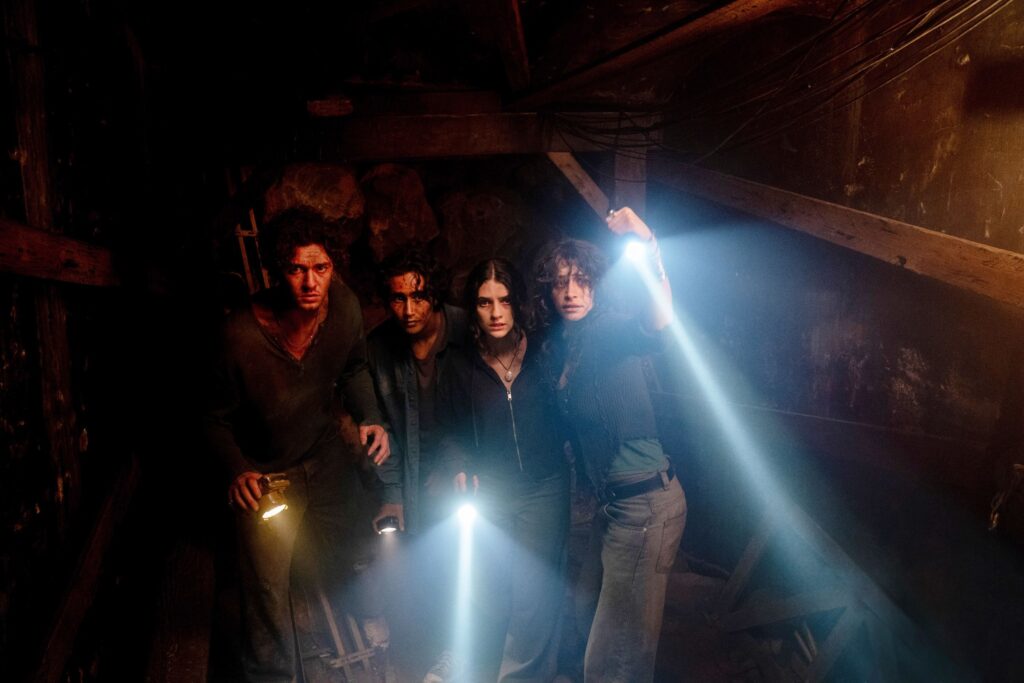There’s way too much going on in Until Dawn. Director David F. Sandberg tried to make a faithful-ish adaptation of the popular 2015 video game, a Groundhog Day-style repeating-day movie, a comedy, a drama with something to say about trauma, and a love letter to every horror subgenre ever, all at the same time. But the byproduct of all this ambition is a movie that never quite finds an identity, and winds up feeling more generic than inspired.
The movie follows a group of teenagers on a road trip to help one member, Clover (Ella Rubin), grieve her sister, who disappeared more than a year earlier. But while most of the group thought the trip would be therapeutic, Clover has been secretly investigating her sister’s last known whereabouts and has put the group on her trail. This leads the five teens to an abandoned mining town called Glore Valley and a mysterious mansion that seems set apart from the rest of the world somehow.
When the group enters the mansion, they realize something strange is going on. They see photos of dozens of people who have gone missing in the town, they sign a strange-looking guest book, they notice an hourglass on the wall. And finally, they all get brutally slaughtered by a mask-wearing killer. Suddenly, they’re all magically transported back to their first moments in the mansion, with memories of their murders still lingering. After a couple more deaths from different kinds of monsters, the group realizes that in order to escape this bizarre place, they’ll have to survive, you guessed it, until dawn.
By the third or fourth reset, with each one ramping up to a new and more interesting kind of horror movie monster, it’s hard not to get excited. Until Dawn, it seems, is telling us exactly what it is: The Cabin in the Woods meets Groundhog Day, a parade of horrors where each fresh night brings something new and terrible. Sure, that isn’t at all what the game is about, but it’s easy to see the promise in this premise. Adding to that is the fact that Sandberg remains an excellent director of horror set-pieces. The monsters that show up during the victims’ first few days in the house aren’t particularly original ones, but Sandberg is incredible at finding new ways to build tension with cinematic tricks, even when we already know the fates our characters are going to meet on each repeating day.
Sandberg and his writers have frequently billed Until Dawn as a love letter to horror movies. And for the first half of the film, it really does feel that way. It’s not exactly reinventing slashers, monster movies, or any of the other subgenres it explores, but each feels well crafted enough to make the filmmakers’ affinity clear.
But just as we settle in to watch this group of characters die over and over as they slowly unravel the secrets to survive, the movie suddenly abandons the premise, skipping ahead multiple days. Rather than actually getting to watch what happened on those days, it’s revealed that one character, Abe (Belmont Cameli), filmed the group’s misadventures on his phone, and we see brief clips from a few of their other deaths.
These clips are far and away the best and scariest work in the film. They have gorgeous practical effects and terrifying creatures, like a skin-invading worm that infects its host with a hideous black goo, while another sees the gang chased by a frighteningly tall man in a trenchcoat and mask, moving in a way that feels entirely inhuman.
It would be one thing to relegate these sequences to this brief cellphone footage montage if it felt like the rest of the film were packed with fresh horrors. Instead, Sandberg spends the rest of Until Dawn’s run time painfully explaining its world and lore to us, and finding a new, deeper rock bottom to the “horror as trauma metaphor” plague that’s infected the genre over the last decade or so. The only brief break we get from this prolonged bore comes when the characters occasionally get chased by the movie’s most underbaked monsters. All of this leaves the distinct feeling that somewhere, trapped on Abe’s cellphone, is a significantly scarier and more exciting version of this movie.
By the end, those first few resetting days and the ones we see via cellphone footage feel like a cruel joke. This could be excused if what replaced it was equally interesting, or even remotely unique. But instead, Until Dawn gets a finale that could have fit right in as the third act to any lesser Blumhouse offering.
The Until Dawn video game is a wonderful, unique horror story with fascinating folklore and big scares, and a story that changes based on player decisions. The game even pulls in clever twists to head off our expectations of what might come next in a slasher or monster movie by swapping to a new subgenre entirely. It’s perfectly understandable that a straight adaptation of that game’s story was never on the table for this movie. And the movie’s excellent repeating-day premise feels like a perfect compromise for the game’s choice-driven mechanics. Ultimately, though, Until Dawn’s movie adaptation doesn’t fail because it’s not faithful to the game. It fails because it’s boring, in a way the game never was.
Until Dawn opens in theaters on April 25.
Content shared from www.polygon.com.

